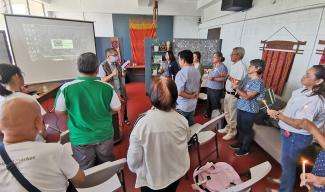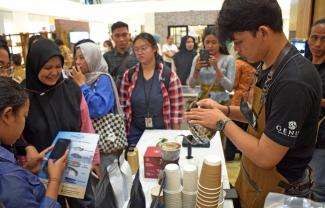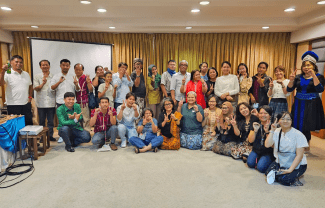Eight-year-old Alpaci and 7-year-old Putri Alisawere were covered in mud, partly drying out on their backs.
Their father was plowing his paddy field with a hand tractor. The two children followed him, collecting worms as bait for fishing in an irrigation ditch.
“Mother will cook the fish if we get it,” said Alpaci.
Alpaci and Putri went farther down to a bigger irrigation channel, where they were pushing a small fish into a corner without any tool, before catching it and putting it into a can. Ignoring the heat of the sun over the Mukim Lamteuba region in Aceh Besar regency, Aceh, they brought the fish home for their family.
Their mother, who had been waiting for them at home, began cleaning the fish.
“Mom’s going to cook it, after dad finishes plowing and returns home, we’ll be dining together,” said Alpaci.
A call to prayer was heard from the mosque of Lamteuba at sunset as farmers were passing blang (paddy fields).
One of the farmers, Fatmi, 37, said there were at least 43 blang areas in Mukim Lamteuba, scattered across eight gampong (villages).
“The location zones are managed by the mukim [subdistrict] administration,” said Fatmi.
“We’re planning to hold a khanduri blang ritual. Next month, our paddy crops will be two months old.”
Khanduri blang, according to Fatmi, is a ritual to express gratitude for God’s blessings. The Lamteuba people conduct at least three khanduri blang ceremonies.
“The first is done before sowing, the second when the crops are two months old and the third when the harvest time arrives,” she explained.
The ritual consists of a prayer service and community dinner. It is also a common tradition in many other regions of Aceh.
The ritual strengthens social bonds and gives villagers a better understanding of the proper management of natural resources, such as water.
“We should protect water sources,” Fatmi said.
The water for irrigating paddy fields in Lamteuba come from springs in a forest zone in the Seulawah mountain range. Locals have acknowledged that forest conservation helps them in the management of resources to sustain their life.
In Lamteuba, stretches of paddy fields are separated by hills and even by clusters of settlements.
Like other Aceh communities, the Lamteuba people live in harmony within the local administrative unit called mukim, which comprises of several villages.
A mukim has territorial borders and natural resources that are autonomously managed on the basis of time-honored ancestral norms and values. In present-day public administration, a mukim ranks below the district level and above villages.
On Aug. 15, 2005, the Indonesian government and the Free Aceh Movement signed a memorandum of understanding known as the Helsinki memorandum of understanding (MoU), which gave Aceh special autonomy status.
A principal provision of the MoU is that the qanun (Muslim bylaw) of Aceh is formulated to show high regard for the history and traditions of Aceh and reflect the latest legal requirements.
Law No.11/2006 on the Aceh administration, providing the basic framework for social life of autonomous province, authorizes the Aceh administration to issue regulations on the reordering of local customs, traditions and administrations. The administration announced the qanun of Aceh No. 10/2008 on customary institutions, which includes the mukim administration.
One of the organizations involved in strengthening the mukim administrative level from the outset of the peace process in Aceh is Yayasan Rumpun Bambu Indonesia (YRBI).
YRBI executive director Sanusi Syarif said Aceh’s special autonomy should be rooted in the traditions and culture existing at the mukim level.
Smile: The women of the Lamteuba region take a selfie during a lunch break after working in the fields.
“The mukim administration should be the management center of customs-based governance and be tasked with assisting the government from the regency to national levels. The important point is that the regional regulation also guarantees that the mukim administration controls the ecological function and natural resource management,” said Sanusi.
The imeum (chief) of Mukim Lamteuba, Bahrum, affirmed that the YRBI had helped his administration formulate custom-based rules connected to water management and irrigation. The mukim administration is striving to create rules to protect water sources and ensure the even distribution of water.
The imeum, along with the village heads, the keujruen blang (mukim head’s assistant in charge of paddy field management) and other community representatives are working on and introducing custom-based rules to this effect.
The customary institution Bahrum directs is revitalizing the functions of relevant personnel as well as customary directives, prohibitions and sanctions. Furthermore, a custom-based dispute settlement system is being formulated and intervillage cooperation in water and irrigation management is being arranged.
“Most importantly, based on customary consensus, we involve women,” Bahrum said.
Women like Fatmi have the role of selecting seeds. Bahrum added that women also had a vital part in khanduri blang and meu uro, which covers all activities having to do with paddy planting, maintenance and harvesting.
The cold but dry air of Lamteuba swept over the expanses of paddy fields at the foot of Mount Seulawah.
Alpaci and Putri had relished the delicious fish fried by their mother. The water irrigating their father’s field had also been shifted to the other fields needing water supply, as already arranged by the mukim administration for equal distribution.
Village life goes on as water flows through the irrigation channels. It is the life Alpaci and Putri are growing into, but will their generation continue to enjoy happiness under Aceh’s special autonomy, or are they going to reverse it and face conflict in a new form?.
This story was first published on thejakartapost.com. December 17, 2019.




